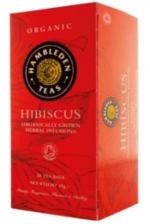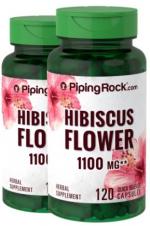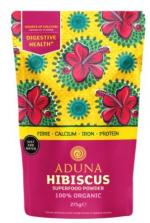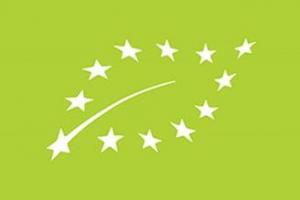
The European market potential for hibiscus
European consumers are increasingly turning to natural products and remedies for disease prevention and maintenance. Immune-boosting supplement are becoming highly popular. Superfoods, such as hibiscus, are used in natural products & nutritional supplements by European companies. There is growing awareness of hibiscus-based health products among European consumers.
Contents of this page
1. Product description
Hibiscus refers to genus of plants in the Malvaceae family. The genus comprises of a few hundred species that grow manly in tropical to warm temperate regions, such as Haiti, South Korea, the Philippines, Ghana and the Ivory Coast. Hibiscus is also known as rose mallow, rose of Sharon and hardy hibiscus. Hibiscus species are for the most part cultivated as ornamental plants, as they produce colourful flowers in various shades of red, peach, pink, orange and white.
Hibiscus has been traditionally used in cosmetics, food and health products. This is because various parts of hibiscus contain active ingredients, such as glycosides, terpenoids, flavoids and saponins. Hibiscus extracts are used as flavouring agents, as well as to enhance the aroma of products. In the cosmetics sector, hibiscus oil is used in formulations, as it is rich in antioxidants and has a pleasant scent. Hibiscus is also used as a natural colourant in products, such as colour cosmetics, hair colours and food products.
This product factsheet pertains to the use of hibiscus in the health products industry. Various parts of the hibiscus plant have different applications. This plant is often used in traditional medicine; for example, roots are used to treat stomach disorders, while leaves are used for laxative properties. Although information and scientific research is limited, there is a potential use for hibiscus in treating hypertension and cancer.
Hibiscus is also known to enhance the immune system, reduce fatigue, support gut health and impart glow to skin. It is considered to be a source of calcium, iron, fibre and plant protein. Hibiscus is traded in the European market as flowers, in a powdered and/or liquid form. As a finished product, hibiscus is sold as a tea, powder, and in a supplement form.
Table 1: Example of hibiscus products in the European health products market
| Tea | 
|
| Food Supplements |

|
| Hibiscus powder | 
|
Source: Various
Hibiscus is traded under the HS Code 121190, which refers to Plants and parts of plants (including seeds and fruits), of a kind used primarily in perfumery, in pharmacy or for insecticidal, fungicidal or similar purpose, fresh or dried, whether or not cut, crushed or powdered. Note, hibiscus represents only a fraction of imports traded under this HS code. This product factsheet only applies to hibiscus used in the health products sector.
Tips:
- Do not make medicinal claims when approaching buyers in the European supplements industry. Familiarise yourself on European Union health claims regulation. See list of permitted health claims under EU law. Under EU law, the use and claim of the word superfood must be supported by scientific evidence. Thus, be prepared to substantiate the use and claim of superfood with scientific data.
- Inform buyers about your hibiscus’s benefits and nutritional profile because these are hibiscus’s key selling points on the European market. Display this information on your company website and marketing materials.
2. What makes Europe an interesting market for hibiscus?
Europe has a prospective market for hibiscus products since consumer demand for natural health products is growing. The ageing population in Europe, as well as rising consumer interest in health and wellness products is stimulating demand. The European market offers good opportunities to hibiscus suppliers in developing countries.
The European market for food supplements is expected to grow in the future. According to the Fortune Business Insights, the European dietary supplements market is projected to reach USD 20.9 billion by 2026. The market is projected to grow at a compound annual growth rate of 4.9 percent until 2026. European consumers are becoming more health conscious, and are looking for natural ways to improve their health and well-being.
Adding hibiscus into one’s diet can have several benefits, including lowering cholesterol. According to Global Alliance for Patient Access, more than half of Europeans suffer from high cholesterol. Cardiovascular disease that can be caused by high cholesterol costs the European economy EUR 54 billion annually in lost productivity. Around EUR 111 billion goes to healthcare expenses and EUR 45 billion goes to informal care in the European Union. With an ageing population and increasing rate of obesity, natural ingredients such as hibiscus offer solutions to many consumers.
Hibiscus also has immunity boosting properties. The COVID-19 pandemic has made European consumers keen to strengthen their personal immunity and overall wellbeing. Hibiscus has a high vitamin C and iron content, which improve the immune system. Rising interest in immune-boosting products is stimulating demand for hibiscus products in Europe.
According to Grand View Research, the global hibiscus flower powder market size was worth USD 113.3 million in 2019. It is forecast that the market will grow at a compound annual growth rate 7.2 percent until 2027.
Figures 1 and 2 show increases in imported volume and value of Plants, parts of plants, incl. seeds and fruits with HS Code 121190 to the EU and the UK. It is shown that growth has occurred in terms of volume and value. However, hibiscus represents only a fraction of imports traded under this HS code.
The demand for hibiscus from the health products sector in Europe is set to grow. Increasing health consciousness among consumers and growing expenditure on healthier food products and dietary supplements, as well as the ageing population in Europe are driving demand for hibiscus-based health products.
Tip:
- See the CBI report on trends on the European heath products sector. You can find more information on how to tap into opportunities on the European health products market.
3. Which European countries offer most opportunities for hibiscus?
Western European countries provide most opportunities to hibiscus suppliers in developing countries. The most prospective countries are Germany, Spain, France, the UK and Italy. These countries have a robust natural health product industry and have some of the largest consumer markets in Europe. Countries such as the Netherlands and Spain are important entry points for raw materials into Europe.
Germany
Table 2: Imports of Plants, parts of plants, incl. seeds and fruits with HS Code 121190 to Germany, 2015-2019
| 2019 | 000 Tonnes | % Change Volume (2015-2019) | m EUR | % Change Value (2014-2018) | Main Exporters | Important Market Players |
| HS 121190 | 72.3 | 13% | 294.2 | 38% | The Netherlands (12.7%), Poland (12.4 %), Egypt (10.9 %) | Africrops, E.H. Worlée & Co |
Source: Eurostat
Table 2 shows German imports of plants, parts of plants, incl. seeds and fruits with HS Code 121190 have increased between 2015 and 2019. However, many other plants and parts of plants are traded under this HS Code.
Germany is a prospective export market for suppliers of hibiscus in developing countries. It has the largest consumer market in Europe; it also has the largest market for organic foods. The market for organic foods has been increasing at a healthy rate and is now the second largest in the world. This makes the German market promising for suppliers of organic hibiscus in developing countries.
According to Mintel, the German supplements market was worth EUR 1.35 billion in 2020. The market grew by 6 percent from EUR 1.17 billion in 2019. It is expected that the market will reach EUR 1.7 billion by 2025.
The most popular vitamins among German consumers are:
● Vitamin D (41 percent)
● Vitamin C (34 percent)
● Multivitamin (33 percent)
The most popular minerals among German consumers are:
● Magnesium (65 percent)
● Iron (29 percent)
● Calcium (29 percent)
● Zinc (26 percent)
Hibiscus has high vitamin C and iron content, which make it appeal to German consumers. The main market players include Africrops and E.H. Worlée & Co.
Germany is a prospective market for hibiscus suppliers in developing countries. There is high demand for high quality and environmentally friendly products. You should target German buyers because of the opportunities it offers.
Spain
Table 3: Imports of Plants, parts of plants, incl. seeds and fruits with HS Code 121190 to Spain, 2015-2019
| 2019 | 000 Tonnes | % Change Volume (2015-2019) | m EUR | % Change Value (2015-2019) | Main Exporters | Important Market Players |
| HS 121190 | 24.8 | 6% | 85.3 | 29% | Morocco (24 %), Egypt (7.7%), USA (7.4%) | El Reloj |
Source: Eurostat
Table 3 shows that imports of Plants, parts of plants, incl. seeds and fruits with HS Code 121190 have increased in terms of value and volume between 2015-2019. In terms of volume, Spain is the second largest importer. However, the HS Code 121190 also represents other plants and parts of plants than hibiscus.
Spain has one of the largest consumer markets in Europe. According to the Association of Dietetic and Food Supplement Companies (AFEPADI), the Spanish nutritional supplements market was valued at EUR 920 million in 2018. According to data from International Marketing Service in Spain (IMS), the most consumed food supplements in Spain in 2015 were:
- Vitamins and minerals: 24%
- Supplements that regulate the nervous system, especially relaxants (plant extracts, melatonin, B vitamins): 9%
- Digestive system supplements: 8%
- Slimming or weight control supplements, such as herbal extracts: 6%
- Laxatives, such as fiber and laxatives: 4%
- Anti-inflammatories, such as collagen and magnesium: 4%
- Diuretics: 1%
- Hepatoprotective supplements: 1%
- Supplements that regulate cholesterol, such as omega 3 acids, glucomannan, monacolin K: 1%
- Others: 42%
Spain has a prospective market for hibiscus because it is the second largest importer of HS code 121190 under which hibiscus is traded in 2019, and has one of the largest consumer markets in Europe. Spain also acts as a re-exporter of raw materials to other European countries.
France
Table 4: Imports of Plants, parts of plants, incl. seeds and fruits with HS Code 121190 to France, 2015-2019
| 2019 | 000 Tonnes | % Change Volume (2015-2019) | m EUR | % Change Value(2015-2019) | Main Exporters | Important Market Players |
| HS 121190 | 19.2 | 11% | 90.5 | 22% | Morocco (15.7%), India (11.6%), Germany (11.3%) | Nexira |
Source: Eurostat
France has one of the largest consumer markets in Europe. It is also an important trader of raw materials to Europe. The imports of Plants, parts of plants, including seeds and fruits with HS Code 121190 increased both in volume and value from 2015 to 2019.
According to Tokster Agence Digitale, the French supplements market was worth EUR 1.9 billion in 2020. The market declined by 1.2 percent from 2019. The reason behind the drop is declining sales of sunscreen and slimming products. However, supplements with immune-boosting properties, and products that relieve stress and improve sleep recorded double-digit growth rates in 2020. The market is expected to bounce back in 2021, and is forecast to be worth EUR 2.3 billion by 2024. Nexira is one of the main market players in France.
France is a prospective market for suppliers of hibiscus in developing countries. Demand for food supplements is increasing.
United Kingdom
Table 5: Imports of Plants, parts of plants, incl. seeds and fruits with HS Code 121190 to the UK, 2015-2019
| 2019 | 000 Tonnes | % Change Volume (2015-2019) | m EUR | % Change Value (2015-2019) | Main Exporters | Important Market Players |
| HS 121190 | 17.5 | 103% | 63.1 | 35% | The Netherlands (28.4%), Germany (15.1%), India (6.2%) | Aduna |
Source: Eurostat
Table 5 shows that the imports of Plants, parts of plants, incl. seeds and fruits with HS Code 121190 to the UK have increased in volume at a triple-digit rate between 2015 and 2019. The UK has one of the largest consumer markets in Europe; it also has one of the largest markets for organic products.
According to Mintel, the UK supplements market was worth almost GBP 500 in 2020. Consumption of Vitamin D increased by 8 percent in 2020. The usage of vitamin C also increased, but the use of all other vitamins decreased in 2020. There is a growing demand for organic products in the UK. Aduna is one of the most important market players.
While the UK is a leading importer, Brexit (Britain’s exit from the European Union) may be disrupting demand for raw materials, such as hibiscus for health products. Many such ingredients used to come in from EU countries, but there are now new regulations, such as customs for the import and trade of products. You should use the International Trade Centre’s (ITC) Market Access Map to see if different tariffs apply when exporting to the UK.
The Netherlands
Table 6: Imports of Plants, parts of plants, incl. seeds and fruits with HS Code 121190 to the Netherlands, 2015-2019
| 2019 | 000 Tonnes | % Change Volume (2015-2019) | m EUR | % Change Value (2015-2019) | Main Exporters | Important Market Players |
| HS 121190 | 12.0 | 49.1% | 50.1 | 38% | Kenya (15.8%), Egypt (9%), USA (8.4%) | Tradin Organic |
Source: Eurostat
Dutch imports of Plants, parts of plants, incl. seeds and fruits with HS Code 121190 increased in value and volume between 2015 and 2019. However, there are other plants and parts of plants traded under HS Code 121190. One leading Dutch importer of hibiscus is Tradin Organic. Other market players include Natural Heroes.
Suppliers of hibiscus in developing countries should target Dutch importers, which usually re-export to other European countries. There is also growing demand for organic hibiscus.
Italy
Table 7: Imports of Plants, parts of plants, incl. seeds and fruits with HS Code 121190 to Italy, 2015-2019
| 2019 | 000 Tonnes | % Change Volume (2015-2019) | m EUR | % Change Value (2015-2019) | Main Exporters | Important Market Players |
| HS 121190 | 11.7 | -4.9% | 70.4 | 12% | India (13.5%), Austria (13.1%), Germany (11.3%) | Natex Ingredients |
Source: Eurostat
Table 7 shows that volume of imported Plants, parts of plants, incl. seeds and fruits with HS Code 121190 decreased between 2015 and 2019, while the value increased. This is due to increasing prices of Plants, parts of plants, incl. seeds and fruits with HS Code 121190 in Italy. Hibiscus imports represent only a fraction of Plants, parts of plants, incl. seeds and fruits that are traded under this HS code.
Italy has one of the largest consumer markets in Europe. It also has one of the most important markets for organic products.
According to Centro Studi FederSalus, the Italian food supplements market was valued at EUR 3.6 billion in 2019. The market increased by about 3.6 percent compared to 2018. Important Natex Ingredients is an important Italian market player.
Italy is a prospective country for exporters of hibiscus in developing countries. Demand for organic products is also increasing in Italy. The market is growing because of rising consumer demand for natural products.
The most prospective markets for exporters of hibiscus in developing countries are in Western Europe. This is because they have some of the largest consumer markets. Also, these consumers prefer to buy high-quality natural products that are beneficial to their health.
Tips:
- Target Western European countries. These countries have the largest food supplement markets and also have robust processing sectors.
- For more information on opportunities in the European health products sector see the CBI study ‘What is the demand for natural ingredients for health products on the European market?’
4. Which trends offer opportunities on the European hibiscus market?
There are several trends in the European health products market for natural ingredients, such as hibiscus. New product launches in the health products sector are stimulating demand. Growing demand for high quality ingredients and products is generating demand for certified organic hibiscus. Many European traders are sourcing organic hibiscus and they see it as an industry standard.
Hibiscus product launches increase awareness
New product launches in the health products and food & beverage market are stimulating demand for hibiscus products in the European market. European consumers in some countries are already familiar with hibiscus tea, but new products, such as powder and beverages are now being launched.
In 2019, one of the leading flavour and fragrance houses Firmenich declared hibiscus as its flavour of the year. This is because of the growing popularity of botanical and floral flavours in food and beverage products. According to Innnova Market Insights, there was a 55 percent increase in new product launches in the tea category between 2014 and 2018.
UK supplier Aduna is an example of a company that launched “super-teas”, which includes a range of teas based on superfood ingredients, such as moringa, baobab, cacao, hibiscus and turmeric, in 2018. In January 2021, Aduna also launched Hibiscus Superfood Powder. The powder is certified organic and is marketed on well-being claims.
It is expected that this trend of new uses for hibiscus will continue in the future. Hibiscus product launches are becoming more common in the health product sector. European consumers are becoming familiar with the hibiscus flavour and its properties.
Tip:
- Keep up to date with innovation in the European health products sector. Follow industry magazines such as Health Food Business and Natural Products. Doing this gives you a better understanding of what is happening in the sector and helps you get prepared when approaching European buyers.
Growing demand for organic hibiscus
There have been substantial issues with quality and contamination of hibiscus in the last few years. European buyers are increasingly demanding certified organic products because they are a sign of quality. A European importer of hibiscus emphasised the importance of organic certification, when he stated that “these kinds of products, you can only sell with an organic certification. I think it’s a basic requirement at this point.”
There is a growing market for organic products in the European market; it was valued at roughly EUR 42 billion in 2019 and is expected to continue to grow in the coming years. Consumers are demanding organic products as they wish to avoid products with synthetic pesticides and related chemicals. Organic certification is often perceived as a sign of quality. Sales of organic products in Europe have been increasing since the COVID-19 outbreak, and the trend is likely to continue.
Exporters are advised to capitalise on this opportunity by getting EU organic certification for their hibiscus. Exporters should also inform buyers of natural ingredients that their hibiscus is certified organic. United for Import & Export is a company exporting EU Organic certified hibiscus to the European market.
Figure 3: Logo EU organic certification

Source: ec.europa.eu
Tips:
- Consider getting organic certification for your hibiscus, as it can help you do business with European buyers seeking organic ingredients.
- Read the CBI hibiscus market entry study , as it provides further information about organic ingredients.
- Visit the IFOAM website for further information on the EU organic certification.
This study was carried out on behalf of CBI by Ecovia Intelligence.
Please review our market information disclaimer.
Search
Enter search terms to find market research